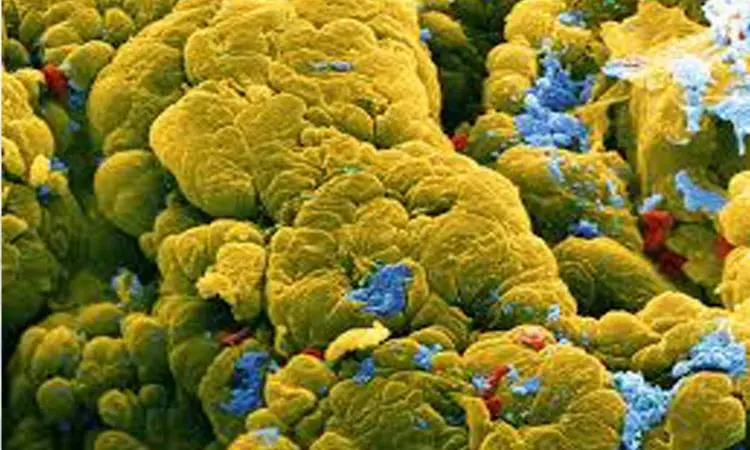- Home
- Medical news & Guidelines
- Anesthesiology
- Cardiology and CTVS
- Critical Care
- Dentistry
- Dermatology
- Diabetes and Endocrinology
- ENT
- Gastroenterology
- Medicine
- Nephrology
- Neurology
- Obstretics-Gynaecology
- Oncology
- Ophthalmology
- Orthopaedics
- Pediatrics-Neonatology
- Psychiatry
- Pulmonology
- Radiology
- Surgery
- Urology
- Laboratory Medicine
- Diet
- Nursing
- Paramedical
- Physiotherapy
- Health news
- Fact Check
- Bone Health Fact Check
- Brain Health Fact Check
- Cancer Related Fact Check
- Child Care Fact Check
- Dental and oral health fact check
- Diabetes and metabolic health fact check
- Diet and Nutrition Fact Check
- Eye and ENT Care Fact Check
- Fitness fact check
- Gut health fact check
- Heart health fact check
- Kidney health fact check
- Medical education fact check
- Men's health fact check
- Respiratory fact check
- Skin and hair care fact check
- Vaccine and Immunization fact check
- Women's health fact check
- AYUSH
- State News
- Andaman and Nicobar Islands
- Andhra Pradesh
- Arunachal Pradesh
- Assam
- Bihar
- Chandigarh
- Chattisgarh
- Dadra and Nagar Haveli
- Daman and Diu
- Delhi
- Goa
- Gujarat
- Haryana
- Himachal Pradesh
- Jammu & Kashmir
- Jharkhand
- Karnataka
- Kerala
- Ladakh
- Lakshadweep
- Madhya Pradesh
- Maharashtra
- Manipur
- Meghalaya
- Mizoram
- Nagaland
- Odisha
- Puducherry
- Punjab
- Rajasthan
- Sikkim
- Tamil Nadu
- Telangana
- Tripura
- Uttar Pradesh
- Uttrakhand
- West Bengal
- Medical Education
- Industry
Night-time exposure to blue light linked to increased risk of colorectal cancer

Blue light has become an increasingly common component of urban outdoor lighting. But how does it impact our health? A team led by the Barcelona Institute for Global Health (ISGlobal), a centre supported by the "la Caixa" Foundation, has conducted the first study of the association between night-time exposure to outdoor artificial light and colorectal cancer. The findings, published in Epidemiology, show that exposure to the blue light spectrum may increase the risk of this type of cancer.
Previous studies have found associations between night-time exposure to artificial light--especially blue light--and various adverse health effects, including sleep disorders, obesity and increased risk of various types of cancer, especially in night-shift workers. Blue light is a range of the visible light spectrum emitted by most white LEDs and many tablet and phone screens. An earlier study by ISGlobal found a link between exposure to blue light at night and increased risk of breast and prostate cancer.
"Using the same methodology as the previous study, we decided to analyse the relationship between exposure to artificial light and colorectal cancer, the third most common type of cancer worldwide after lung and breast cancer," explained Manolis Kogevinas, Scientific Director of the Severo Ochoa Distinction at ISGlobal and coordinator of the new study. The World Health Organisation's International Agency for Research on Cancer (IARC) classifies night-shift work as probably carcinogenic to humans; breast, prostate and colorectal cancer are associated with the highest risk.
The authors analysed data obtained through the MCC-Spain project on approximately 2,000 adults in Barcelona and Madrid, of whom 660 had colorectal cancer and the rest were randomly selected from the local population. Individuals with a history of working night shifts were excluded. Night-time levels of outdoor artificial light were determined using images from the International Space Station (ISS).
Results from both cities showed that participants with the highest exposures to blue light had a 60% higher risk of developing colorectal cancer than the less exposed population. No association was found with full-spectrum light.
"Night-time exposure to light, especially blue-spectrum light, can decrease the production and secretion of melatonin, depending on the intensity and wavelength of the light," explains Kogevinas.
Because exposure to light was estimated using satellite images, this calculation did not take into account individual behaviours such as the use of rolling shutters, which is common in Spain and other Mediterranean countries. The estimate of exposure can therefore be interpreted as the amount of light people are exposed to when they are outside their homes--a common pattern in Spain--and inside their homes before closing the shutters and going to bed.
"There is growing concern about the effects of light on ecosystems and human health," commented Kogevinas. "Research on the potential effects of light exposure is still in its infancy, so more work is needed to provide sound, evidence-based recommendations to prevent adverse outcomes."
Hina Zahid Joined Medical Dialogue in 2017 with a passion to work as a Reporter. She coordinates with various national and international journals and association and covers all the stories related to Medical guidelines, Medical Journals, rare medical surgeries as well as all the updates in the medical field. Email: editorial@medicaldialogues.in. Contact no. 011-43720751
Dr Kamal Kant Kohli-MBBS, DTCD- a chest specialist with more than 30 years of practice and a flair for writing clinical articles, Dr Kamal Kant Kohli joined Medical Dialogues as a Chief Editor of Medical News. Besides writing articles, as an editor, he proofreads and verifies all the medical content published on Medical Dialogues including those coming from journals, studies,medical conferences,guidelines etc. Email: drkohli@medicaldialogues.in. Contact no. 011-43720751


